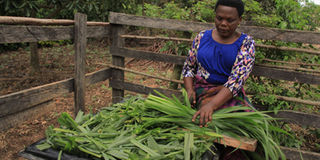Juggling dairy, fruits, banana and cofffee

Annet Kyinkuhaire, a farmer in Mooya village, Kitura Sub-county in Kiruhura District, prepares napier grass to feed dairy cows on her farm. Photo by Rachel Mabala
What you need to know:
Annet Kyinkuhaire grows bananas, pasture, and vegetables and also rears both goats and cows. She says for efficient mixed farming, one should plan carefully lest this kind of farming turns out to be a burden as the farmer may be unable to maximise productivity, writes Fred Muzaale
Annet Kyinkuhaire, a farmer in Mooya village, Kitura Sub-county in Kiruhura District, went into farming initially because she wanted to give her children a good education.
She realised that if anything was to happen and she loses her job, she would not be in a position to give her children the education they deserved.
And so, to ensure that she had enough money for her dream and that of her children, Kyinkuhaire ventured into mixed farming in 2012.
Today, she runs a mixed farm which includes livestock, horticulture, banana plantation and citrus fruits.
Like many other farmers in Uganda, Kyinkuhaire used to rely on maize farming and keeping livestock. However, the yields from her farm were discouraging because she lacked proper knowledge of good farming practices.
Enterprises
She has two acres of coffee and two acres of bananas. She also grows fruits including avocadoes, pineapples, mangoes, oranges and paw paws. But that is not all; she keeps dairy cows, and goats.
“I started farming way back in 2012,’’ says Kyinkuhaire, who began by growing bananas and vegetables. “I ventured into other crops after realising that farming can pay. Since then I have never looked back.”
She harvests her bananas twice a week. One bunch of banana at farm gate costs Shs10,000 and she can harvest up to 20, which earns Shs200,000.
One would not expect her to get a ready market in Kiruhura Town, which is the home of bananas.
But Kyinkuhaire has found a niche and has a loyal customer base which gives her an average of Shs600,000 a month from bananas.
Orchard
Her orchard produces a variety of fruits. She sells avocadoes in Mbarara and Kiruhura districts. One kilogramme fetches between Shs1,000 and Shs3,000 depending on the type.
Dairy
In 2014, she decided to buy some dairy cows, mainly of Friesian and Ayrshire breeds to supplement her indigenous herd.
“I bought my cows while they were still young and nurtured them until maturity.”
She now milks them, producing more than 50 litres of milk a day. She supplies the milk mainly to restaurants and schools in the area. Her neighbours are also her customers. She sells a litre of fresh milk at Shs500.
To ensure that her cows have constant supply of sufficient feeds, she has planted Napier grass and set aside part of the land for grazing.
In addition to the dairy meal she buys from the local market, she uses banana leaves and maize cobs to feed the animals. Dairy farming has in turn improved her crop yields as she gets a lot of manure from the cow dung and urine.
Why mixed farming
“I received training from aBi officials. I also obtained a certificate in agriculture after attending a short course in Mbale,” says Kyinkuhaire.
She encourages other farmers to try mixed farming and stop relying on a single crop all-year-round because market trends are unpredictable.
“You should have little of everything at any given time,” she says.
Over time, she has learnt to plant different crops at different times of the year, doing her best to anticipate demand in the market.
For instance she says that the demand for cabbages, tomatoes, potatoes and onions increases between April and June every year, at least in major towns.
“I normally have a competitive edge during this period because many farmers lack the produce to take to the market,” he says.




